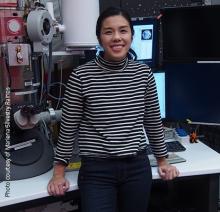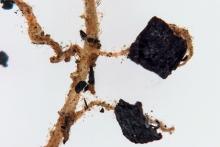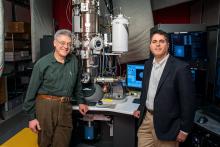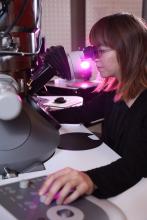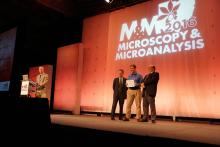Congratulations to Kayla, “Use it!” Lemelson-MIT Prize Winner for her work on the Electron Microscope Pixel Array Detector (EMPAD) and airSTEM!
More information
Cornell University graduate student awarded Department of Energy fellowship
Ames, Iowa (September 18, 2017)
Gabriela Correa, a doctoral candidate in David Muller’s group at Cornell University, has been awarded a Department of Energy Computational Science Graduate Fellowship (DOE CSGF) to support her Materials Science research. Correa, from Sleepy Hollow, New York, received bachelor’s degrees in Mathematics and Electrical Engineering from the University of Massachusetts Amherst. Less than 5 percent of applicants are chosen for the fellowship each year. The DOE CSGF, administered by the Krell Institute of Ames, Iowa, is funded by the DOE’s Office of Science and the National Nuclear Security Administration. Each year, the program grants fellowships to support doctoral students whose education and research focus on using high-performance computers to solve complex science and engineering problems of national importance. Since it was launched in 1991, the DOE CSGF has supported 436 students at more than 65 universities. DOE CSGF students receive full tuition and fees plus an annual stipend and academic allowance, renewable for up to four years. In return, recipients must complete courses in a scientific or engineering discipline plus computer science and applied mathematics. They also must do a three-month research practicum at one of 21 DOE laboratories or sites across the country. Correa joins a group of 20 first-year fellows in 2017, bringing the total number of current DOE CSGF recipients to 79 students in 14 states. The fellowship and related practicum experiences are effective workforce recruitment tools for the national laboratories. Nearly a quarter of all DOE CSGF alumni currently work or have worked in a DOE lab setting. Others pursue careers in academia, industry or government, where they introduce and advocate for computational science as a tool for discovery.
For more information on the DOE CSGF, contact the Krell Institute at 515-956-3696 or visit http://www.krellinst.org/csgf.
The Muller group has helped to discover previously unknown electron transfer pathways in Biochar in soil, which may be vital for soil microorganisms. The cross-disciplinary study was led by Tianran Sun and Johannes Lehmann from Cornell’s Department of Crop and Soil Sciences. Read more at the Cornell Chronicle! http://www.news.cornell.edu/stories/2017/03/researchers-discover-high-de…
Read about the Electron Microscope Pixel Array Detector (EMPAD) in the Cornell Chronicle!
“like taking a photograph of a sunset that showed both details on the surface of the sun and the details of darkest shadows”
http://www.news.cornell.edu/stories/2017/03/new-electron-microscope-sees…
Gabriela Calinao Correa was selected to receive a 2017 National Science Foundation (NSF) Graduate Research Fellowship Program (GRFP) Fellowship!
Watch Prof. Muller explain the behaviour of gold atoms on Nova’s Treasures of the Earth: Metals on PBS!
Warning: The narrator may have decided to call me Mewler.
Microscopy and Microanalysis 2016, Columbus Ohio: Barnaby Levin receives a Student Scholar Award for his abstract: “Reverse Engineering Cadmium Yellow Paint from Edvard Munch’s “The Scream” with Correlative 3-D Spectroscopic and 4-D Crystallographic STEM”. The abstract describes how we’re combining spectroscopy and 4D-STEM to reveal the nanoscale structure of paint from Edvard Munch’s masterpiece, The Scream (c. 1910, Munch Museet, Oslo, Norway). Our work is being done in collaboration with scientists at the University of Delaware, and at the Munch Museum in Norway.
The abstract can be accessed online at: https://www.cambridge.org/core/journals/microscopy-and-microanalysis/art…
A new atomically-ordered Pt-Co nanoparticle catalyst boosts the efficiency of the proton-exchange membrane fuel cells targeted for fuel-cell electric vehicles.
Watch what happens when you bend and break the world’s thinnest glass: Cornell Chronicle, NBC News, LiveScience.com, Gizmodo
Shattering records: Thinnest glass in Guinness book
“At just a molecule thick, it’s a new record: The world’s thinnest sheet of glass, a serendipitous discovery by scientists at Cornell and Germany’s University of Ulm, is recorded for posterity in the Guinness Book of World Records.” Cornell Chronicle, LA Times, NBC News, Fox News, Huffington Post
“Direct Imaging of a Two-Dimensional Silica Glass on Graphene”,
Pinshane Y Huang, Simon Kurasch, Anchal Srivastava, Viera Skakalova, Jani Kotakoski, Arkady V. Krasheninnikov, Robert Hovden, Qingyun Mao, Jannik C. Meyer, Jurgen H. Smet, David A. Muller, and Ute Kaiser, Nano Letters, (2012). DOI: 10.1021/nl204423x
“Atomic-Scale Chemical Imaging of Composition and Bonding by Aberration-Corrected Microscopy”,
D. A. Muller, L. Fitting Kourkoutis, M. Murfitt, J. H. Song, H. Y. Hwang, J. Silcox, N. Dellby, O. L. Krivanek,
Science 319, p. 1073 (2008)”
Cornell Chronicle: A STEM in Color
Science Daily: New Electron Microscope Identifies Individual Color-coded Atoms
Analytical Chemistry: Electron microscopy comes into focus
“Grains and Grain Boundaries in Single-Layer Graphene Atomic Patchwork Quilts”,
P. Y. Huang, C. S. Ruiz-Vargas, A. M. van der Zande, W. S. Whitney, M. P. Levendorf, J. W. Kevek, S. Garg, J. S. Alden, C. J. Hustedt, Y, Zhu, J. Park, P. L. McEuen, and D. A. Muller,
Nature doi: 10.1038/nature09718 (2011)”
Cornell Chronicle:Graphene patchwork quilts
Discover Magazine
“Pt-Decorated PdCo @ Pd / C CoreShell Nanoparticles with Enhanced Stability and Electrocatalytic Activity for the Oxygen Reduction Reaction”,
D. Wang, H. L. Xin, Y. Yu, H. Wang, E. Rus, D. A. Muller, and H. D. Abruna,
JACS 132, p. 17664-17666 (2010)”
Cornell Chronicle:Platinum-coated nanoparticles could power fuel cell cars
“Microscopic origins for stabilizing room-temperature ferromagnetism in ultrathin manganite layers”,
L. F. Kourkoutis, J. H. Song, H. Y. Hwang, and D. A. Muller,
PNAS 90, p. 4731-4749 (2010)”
“Three-dimensional imaging of pore structures inside low-kappa dielectrics”,
H. L. Xin, P. Ericus, K. J. Hughes, J. R. Engstrom, and D. A. Muller,
APL 96, 223108 (2010)”


